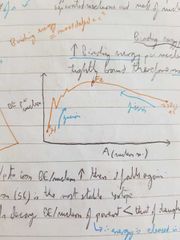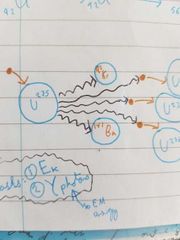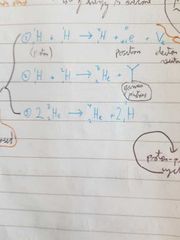![]()
![]()
![]()
Use LEFT and RIGHT arrow keys to navigate between flashcards;
Use UP and DOWN arrow keys to flip the card;
H to show hint;
A reads text to speech;
30 Cards in this Set
- Front
- Back
|
2 assumptions of Einstein's equation |
Mass is a form of energy e.g. annihilation of masses of particle and antiparticle to energy of gamma photons produced Energy has mass e.g. moving objects have negligibly greater mass when moving than at rest |
|
|
Radioactive decay and E=mc2 |
Conservation of mass/energy rather than individually Therefore decay that releases energy must have an accompanying mass decrease |
|
|
Ek minimum of reactants in annihilation or pair production |
Ek min = (mproducts - mreactants) c^2 |
|
|
Binding energy |
Minimum energy to separate a nucleus into it's constituent protons and neutrons |
|
|
Why mass defect is a thing |
For binding energy to happen, work must be done against nuclear strong force Therefore more energy means more mass |
|
|
Mass defect |
Difference in mass of completely separated nucleons and the nucleus as a whole Former is heavier as work was done |
|
|
How does A affect binding energy |
Bigger mass number A = stronger nuclear force = greater binding energy |
|
|
Higher binding energy per nucleon = |
More tightly bound nucleus More stable |
|
|
A and binding energy per nucleon graph and explanation |

Up to iron BE increases so fusion of elements happens as energy is released Iron and above BE decreses so fission happens to get elements with higher BE so energy is also released Iron is most stable isotope |
|
|
Why does decay release energy |
Because BE per nucleon of daughter nucleus is smaller This energy difference is released in decay |
|
|
Induced fission |
Firing neutrons at stable mined U238 source to make it more unstable to start a chain of fission reactions once it becomes U235 |
|
|
Thermal neutrons |
Ekmin similar to that of thermal energy of particles in reactor core Absorbed by uranium nuclei |
|
|
Intermediate neutrons |
Absorbed by U238 to form highly dangerous Pu239 |
|
|
Fast neutrons |
Emitted from fission reactions Bounce off U235 nuclei |
|
|
Why we fire a thermal neutron at U235 |
To absorb it forming U236 which is more likely to split spontaneously undergoing fission |
|
|
U235 fission reaction |

|
|
|
How to calculate energy fission releases |
Difference in reactant and products binding energies |
|
|
Where does energy go in a fission |
All products mass, kinetic energy of products, and gamma photons as EM energy |
|
|
Fuel rods |
Made of a fissile material e.g. U 235 Power fission reactions |
|
|
Fissile |
Material that can sustain induced fission chain reactions |
|
|
Control rods |
Absorb neutrons to slow down or stop fission process and control chain reaction Made of boron or cadmium as tgese readily absorb neutrons |
|
|
Moderator |
Slow down fast fission neutrons that bounce of nuclei so they become thermal neutrons These can be absorbed so have a greater chance of inducing fission
Made of D2O or graphite as these are the right size to have their nuclei collide with the neutrons |
|
|
Environmental impact of fission and how to deal with it |
Produces Pu 239 which has v long t1/2 and is highly ionising
Must be stored at stable site where it can't contaminate groundwater
Can be solidified with glass |
|
|
Different risks |
Low risk 80% of waste Clothing/waste paper Medium risk Radioactive enough to need shielding Resins High risk 5% of waste Produces 95% of the activity Fuel rods |
|
|
Why fusion needs high temps |
Needs to overcome ES repulsion between positive nuclei So needs to get fm close Therefore needs lots of energy for speed to get this close |
|
|
3 fusion reactions in stars |

|
|
|
Where is antimatter found |
Sun Particle accelerators Space |
|
|
How does fusion happen a bit at lower temperatures |
Each particle has a vastly different Ek Some are large enough for fusion |
|
|
What is released energy released as |
Ek |
|
|
Why does fission release energy |
Products have higher binding energy Products have lower mass Energy released |

